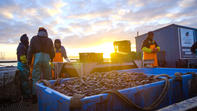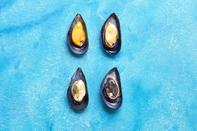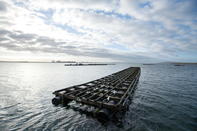The term ‘mussels’, refers to both freshwater and seawater bivalve molluscs - double-shelled snails - which filter-feed on algae from the surrounding water, usually in the intertidal zone. In this article, we refer to the commercial production of black mussels in seawater. White mussels in South Africa are used mainly for bait.

Species of Mussels
Mussels are called black mussels because of their black shells. The commonly known Mediterranean mussel, also known as the Spanish mussel the Mytilus galloprovinciali, is one of two species used for farming in South Africa. The flesh of this species is white to cream in males or orange in females.
South Africa’s indigenous black mussel species, the Choromytilus meridionalis, naturally settles on the ropes and is also used in mussel farming. The flesh of the indigenous black mussels is black or blue.
Both species taste similar.

Production Cycle of Mussels
Most mussels in South Africa are farmed in Saldanha Bay on the West Coast. The bay is perfect for mussel farming as the windy West Coast creates upwelling currents that bring in clean, cold and nutrient-rich water, on which the mussels feed. Mussel farming is usually conducted in quiet bays not exposed to high-energy wave action. The West Coast is considered more nutrient-rich compared to the waters of the southern Cape coast where the growth rate is slower.
Mussels are filter feeders and filter phytoplankton from the surrounding seawater. Each mussel can filter 2 to 3 litres of seawater per hour.
The mussel’s natural reproductive cycle depends on the cycle of the moon and water temperature, with the optimal temperature being around 15℃. Mussels release their eggs into the water, about 5 to 12 millions of eggs per female mussel. Of these, it is estimated that about 10 000 eggs will survive as larvae.
After release, eggs are fertilised and within 24 hours, little swimming mussel larvae emerge. Three weeks later, the 3 mm larvae attach to a substrate and in the case of farmed mussels, onto ropes hanging from floating rafts.

Mussel ‘beards’ or byssus are used to adhere to the substrate. These byssal threads are made of long silky filaments, secreted as a liquid cement-like substrate, which sets when it comes in contact with seawater. After attaching, larvae will start forming a hard shell and are then called ‘spat’. Mussel shell consists mostly of calcium carbonate.
In mussel farming, mussels may be seeded monthly to allow for year-round production or rely on natural seeding.
When they reach about 2.5 cm, mussel spat is stripped from the ropes, taken ashore and size graded. They are then put in mesh bags also called ‘socks’, which are suspended from longlines floating on the water’s surface.
Through their growing phase, mussels are thinned out to prevent food competition and promote more even growth. From the larvae stage to market size of 8 - 9 cm takes about 12 months, however, in certain farms Mediterranean mussels may be harvested as soon as seven months (60 g). When harvested, about 50% of the mussels are of commercial size and is market ready, the rest is returned to new ropes and suspended once again to continue growing.
Mussels are harvested into crates on boats and taken to the processing facility where they undergo a process called ‘conditioning’. During this process, mussels are kept in purified seawater for a few days before being packed and shipped. Mussels may also be processed individually, quick frozen or cooked.
By Marinda Louw